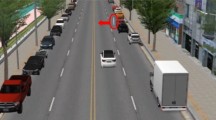Abstract
A private vehicle frequently carries the same passengers who routinely take specific objects with them, have their vehicle comfort preferences, and visit the same places at relatively the same time of a given day or day of the week. Thus, developing intelligent vehicles that are able to reduce the cognitive workload of the drivers by learning and adapting to their occupants’ routines is of the highest interest. In this paper, we present two independent models based on machine learning methods, including artificial neural networks and linear and ridge regressions, to learn the habits and preferences of the vehicle’s users. The first model is responsible for predicting the next vehicle trip state, i.e., the departure location and time, and the driver, passenger, and object states. The second model anticipates the comfort setting inside the cockpit - temperature, cockpit mirror, and driver seat poses. The developed models were trained, evaluated, and validated with different datasets in the Portuguese city of Braga. The results prove that the vehicle efficiently learns the routines of several users with varying complexities. Prediction errors happen in cases of an exceptional, one-time deviation from routine behavior.
*The work received financial support from European Structural and Investment Funds in the FEDER component, through the Operational Competitiveness and Internationalization Programme (COMPETE 2020) and national funds (Project “Easy Ride: Experience is everything”, ref POCI-01-0247-FEDER-039334), and R &D Units Project Scope: UIDB/00319/2020 and UIDB/00013/2020.
Access this chapter
Tax calculation will be finalised at checkout
Purchases are for personal use only
Similar content being viewed by others
References
Andropov, S., Guirik, A., Budko, M., Budko, M.: Network anomaly detection using artificial neural networks. In: 2017 20th Conference of Open Innovations Association (FRUCT), pp. 26–31. IEEE (2017)
Belkin, M., Hsu, D., Ma, S., Mandal, S.: Reconciling modern machine-learning practice and the classical bias-variance trade-off. Proc. National Acad. Sci. 116(32), 15849–15854 (2019)
Eagle, N., Pentland, A.S.: Eigenbehaviors: identifying structure in routine. Behav. Ecol. Sociobiol. 63(7), 1057–1066 (2009)
Fernandes, C., Ferreira, F., Erlhagen, W., Monteiro, S., Bicho, E.: A deep learning approach for intelligent cockpits: learning drivers routines. In: International Conference on Intelligent Data Engineering and Automated Learning, pp. 173–183. Springer (2020). https://doi.org/10.1007/978-3-030-62365-4_17
Goldberg, Y.: Neural network methods for natural language processing. Synth. Lect. Hum. Lang. Technol. 10(1), 1–309 (2017)
Gonzalez, M.C., Hidalgo, C.A., Barabasi, A.L.: Understanding individual human mobility patterns. Nature 453(7196), 779–782 (2008)
Guimarães, P., Ferreira, F., Silva, A.C., Erlhagen, W., Monteiro, S., Bicho, E.: A data recording mobile application to create datasets of vehicle users’ routines. In: 2022 IEEE International Conference on Autonomous Robot Systems and Competitions (ICARSC), pp. 167–172. IEEE (2022)
Guliyev, N.J., Ismailov, V.E.: On the approximation by single hidden layer feedforward neural networks with fixed weights. Neural Netw. 98, 296–304 (2018)
Ibrahim, R., Shafiq, M.O.: On predicting taxi movements modes in Porto city using classification and periodic pattern mining. In: 2019 IEEE 21st International Conference on High Performance Computing and Communications; IEEE 17th International Conference on Smart City; IEEE 5th International Conference on Data Science and Systems (HPCC/SmartCity/DSS), pp. 1197–1204. IEEE (2019)
Jia, R., Khadka, A., Kim, I.: Traffic crash analysis with point-of-interest spatial clustering. Accid. Anal. Prev. 121, 223–230 (2018)
Park, S.H., Kim, B., Kang, C.M., Chung, C.C., Choi, J.W.: Sequence-to-sequence prediction of vehicle trajectory via LSTM encoder-decoder architecture. In: 2018 IEEE Intelligent Vehicles Symposium (IV), pp. 1672–1678. IEEE (2018)
Roth, C., Kang, S.M., Batty, M., Barthélemy, M.: Structure of urban movements: polycentric activity and entangled hierarchical flows. PloS One 6(1), e15923 (2011)
Schmidhuber, J.: Deep learning in neural networks: an overview. Neural Netw. 61, 85–117 (2015)
Schubert, E., Sander, J., Ester, M., Kriegel, H.P., Xu, X.: DBSCAN revisited, revisited: why and how you should (still) use DBSCAN. ACM Trans. Database Syst. (TODS) 42(3), 1–21 (2017)
Simmons, R., Browning, B., Zhang, Y., Sadekar, V.: Learning to predict driver route and destination intent. In: 2006 IEEE Intelligent Transportation Systems Conference, pp. 127–132. IEEE (2006)
Song, C., Qu, Z., Blumm, N., Barabási, A.L.: Limits of predictability in human mobility. Science 327(5968), 1018–1021 (2010)
Wojtak, W., et al.: Towards endowing intelligent cars with the ability to learn the routines of multiple drivers: a dynamic neural field model. In: International Conference on Computational Science and Its Applications, pp. 337–349. Springer (2021). https://doi.org/10.1007/978-3-030-86973-1_24
Yang, S.X., Meng, M.: An efficient neural network approach to dynamic robot motion planning. Neural Netw. 13(2), 143–148 (2000)
Author information
Authors and Affiliations
Corresponding author
Editor information
Editors and Affiliations
Rights and permissions
Copyright information
© 2022 The Author(s), under exclusive license to Springer Nature Switzerland AG
About this paper
Cite this paper
Barbosa, P. et al. (2022). Endowing Intelligent Vehicles with the Ability to Learn User’s Habits and Preferences with Machine Learning Methods. In: Yin, H., Camacho, D., Tino, P. (eds) Intelligent Data Engineering and Automated Learning – IDEAL 2022. IDEAL 2022. Lecture Notes in Computer Science, vol 13756. Springer, Cham. https://doi.org/10.1007/978-3-031-21753-1_16
Download citation
DOI: https://doi.org/10.1007/978-3-031-21753-1_16
Published:
Publisher Name: Springer, Cham
Print ISBN: 978-3-031-21752-4
Online ISBN: 978-3-031-21753-1
eBook Packages: Computer ScienceComputer Science (R0)




